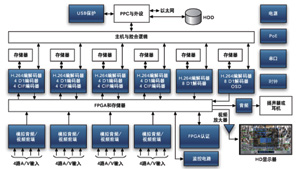The analog CCTV security surveillance system is transitioning to digital technology, and the demand for video is an important factor in leading this trend. In security surveillance systems that require video surveillance and recording, analog VCRs have been replaced by digital video recorders (DVRs). In security monitoring applications, DVRs have an overwhelming advantage over analog VCRs. Continuous video images are recorded, processed, and transmitted over digital networks for virtually any level of image quality, including high definition (HD). Users can use digital processing technologies such as real-time analytics, live search, mobile and activity detection alarms, and remote access over IP networks. The storage cost of a physical carrier, such as a hard disk (HDD), digital versatile disk (DVD), or network storage (NAS) device, is only a fraction of the cost of analog video tape. The use of digital video and archiving technology also helps to permanently save video recordings without compromising image quality over time. All of these factors drive the DVR as a standard for video recording in the security surveillance arena.
This article refers to the address: http://
The DVR type security monitoring market has experienced several different stages of DVR development. Embedded, hybrid, and PC-based DVRs, all of which require basic video and audio acquisition units: analog-to-digital conversion, compression, playback, and network streaming. The embedded DVR is a stand-alone device that accepts analog CCTV camera inputs, compresses and stores them in a local HDD; a hybrid DVR can accept analog CCTV and IP camera inputs as a video source; a PC-based DVR with a hardware compression card Or a software compression program running on the PC is integrated in the security monitoring station. Key features of different modules include: number of video input channels, supported compression standards, recording quality, stream processing and playback modes, storage capacity, and the number of functions that the system can perform simultaneously.

Figure 1 Functional block diagram of the safety monitoring DVR system
Video compression technology
H.264 is the new industry standard for security surveillance DVR video compression. Compared to the previous generation of MPEG-4, and even MJPEG standard video technology, H.264 has the advantage of a higher compression ratio and can provide high quality images for security surveillance systems. The higher compression ratio of H.264 (which is twice that of the previous generation compression technology) enables a 100% capacity expansion and a smaller file size to record longer images on fixed-capacity storage devices. In addition, H.264 compression technology enables high-quality images to be transmitted over the network at very low bit rates. Without efficient compression, a multi-camera security monitoring system will soon exceed the available bandwidth of the network. In order to extend the recording time and reduce the video bit rate, DVR systems that do not use H.264 compression technology have to reduce the video frame rate or sharpness, thereby reducing the image quality. To ensure backward compatibility of products, many systems still use the traditional codec format (MPEG-4 and MJPEG). However, from the current development trend, H.264 has become the primary codec technology for DVRs in the industry.
DVR system requirements Video security monitoring systems are increasingly demanding video and clear images. Most of the early DVR video definitions used CIF (NTSC 360×240), and the digital video quality was comparable to the analog VCR replaced. The low-definition CIF is also suitable for the first-generation codec technology (MJPEG/MPEG-4), but the image compression ratio of this technology is no longer sufficient for HD systems. Current market demand and trends are standard definition (D1 NTSC 720 x 480) or "DVD quality" video recordings. Compared to CIF, the standard definition (SD) system has a four-fold increase in processing power per channel. The H.264 codec technology, which represents the state of the art, is widely used in D1 resolution or higher definition systems to ensure efficient compression ratios. Maxim's H.264 family of processors offers the flexibility to set video resolution to meet the video quality requirements of different video systems.
Another trend in video security and surveillance is full frame rate recording and storage. The full frame rate of an analog CCTV camera is 30 fps in NTSC and 25 fps in PAL. Compared to DVR designs with reduced frame rate, for example, 7.5fps (25% of NTSC) or 15fps (50% of NTSC), the real-time video recording system requires 2 to 4 times more processing power per channel. To meet the processing needs of the new DVR design, a powerful scalable system architecture is required.
Over time, most video security surveillance systems on the market today use a hybrid architecture that emulates CCTV equipment and digital network technology. Traditional digital devices are based on early codec technology (MJPEG/MPEG-4), which requires new devices to support conversion in both formats. For example, video signals acquired by IP cameras using the current MJPEG compression algorithm must be re-encoded in the DVR to H.264 format for efficient storage and full utilization of network bandwidth. Current DVR designs must accept multi-format digital video input (MJPEG/MPEG-4/H.264) to protect investments in early equipment. Maxim's H.264 family of processors can perform MJPEG and MPEG2 decoding before re-encoding to H.264 format, supporting video and data stream processing for new systems.
Low Frequency Inverter Charger
Low Frequency Inverter Charger
Have good environmental adaptability. Resistant to high temperatures, dust, stable output. Suitable for outdoor, vehicle, office space.
Low Frequency Inverter Charger,Low Frequency Inverter 24V,Low Frequency Inverter,Car Power Charger
SUZHOU DEVELPOWER ENERGY EQUIPMENT CO.,LTD , https://www.fisoph-power.com